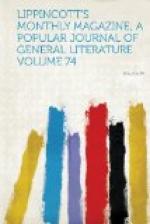Such is the story of the Sonnets, the saddest of all stories, as it comes to us from the simple and unbiased reading of the series as it stands, without alteration or transposition. The meaning is sufficiently obvious without making any change, although, judging from the purely eulogistic character of some of the first series of the Sonnets, and the purely reflective style of others, it seems probable that those which are more or less reproachful in tone may belong together, nearer the second series. Still, even to this rearrangement there are objections when we consider the alternations of feeling and the different conditions that must have affected the poet during the space of time covered by these poems. In the 104th Sonnet three years are mentioned as having elapsed since the friends first met, and the time covered by the whole series was probably still longer. Conjectural evidence points to William Herbert as the person to whom the Sonnets are addressed. His name, his age, his beauty, his rank, all agree with Shakespeare’s description. As for the earl of Southampton, the poet’s early patron, to whom the Venus and Adonis and the Lucrece are dedicated, his name was Henry; he was but nine years younger than Shakespeare, and therefore not likely to have been called by him “a sweet boy;” he was a remarkably plain man, instead of an Adonis, and noted, not for his devotion to women in general, but for his ardent attachment to Mistress Elizabeth Vernon, whom he married secretly, in spite of the queen’s opposition, in 1598. Now, the earliest mention that we have of Shakespeare’s poems is when Meres speaks of “his sugared sonnets among his private friends.” This was in 1598, and, as Hallam and other critics have argued, is probably a reference to earlier sonnets which have been lost, not to those published in 1609. It was in 1598 that William Herbert, a brilliant and fascinating young man, addicted to pleasure and susceptible to flattery, but strongly disinclined to marriage, came up to London to live, having visited the metropolis during the previous year.
As for Lady Rich, besides the objections already urged on the score of her personal appearance and her age, Shakespeare would never have dared to speak of a reigning beauty of the court in the words of Sonnets 137, 144, 152. In fact, Mr. Massey’s whole argument upon this head is based upon his assertion that the poems are dramatic and not personal.
Mr. Massey’s conviction that Marlowe is the rival poet of whose “great verse” Shakespeare was jealous depends upon Southampton, and not Herbert, being acknowledged to be the friend addressed, for Marlowe died in 1593, when Herbert was but thirteen years old, and five years before we have the first mention of Shakespeare as a writer of sonnets. Certainly, a writer who had died five years before we find any mention of the Sonnets can hardly be the living poet of whom Shakespeare distinctly speaks in Sonnets 80 and 86. Also in Sonnet 82 he makes mention of the “dedicated words” this rival addresses to his friend. Now, we have no evidence that Marlowe ever dedicated anything to Southampton, although Mr. Massey tries to bolster up a desperate case by saying that “there is nothing improbable in supposing that Marlowe’s Hero and Leander was intended to be dedicated to Southampton” had the poet lived to finish it!




